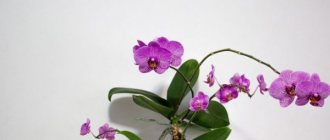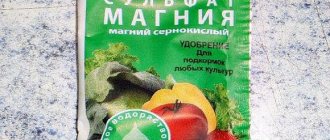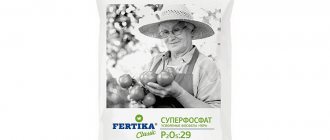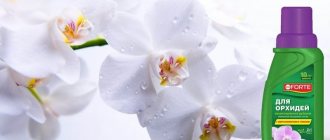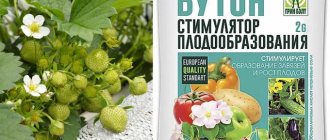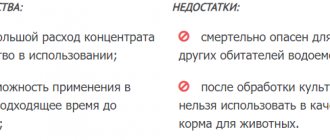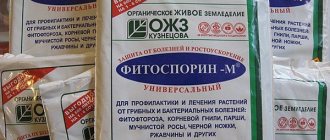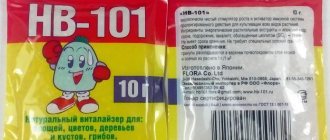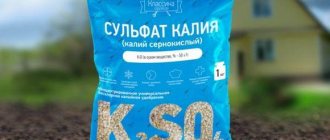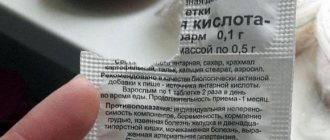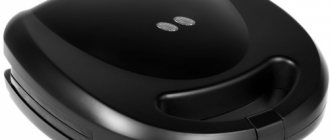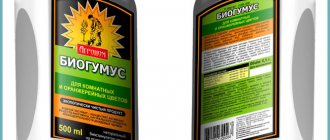Any indoor plant requires proper care. When choosing top dressing, it is important to pay attention to the condition of the soil, the characteristics of the plant and growing conditions.
Thanks to fertilizers containing nutrients, you can create optimal conditions for plant growth.
Fusco is a popular company that produces plant nutrition. Depending on the type of preparation, the composition and properties of the fertilizer change. The main components of any fertilizer are: nitrogen, potassium, manganese, potassium, cobalt, copper and zinc.
In professional terms, this is a specialized complex liquid fertilizer with microelements in chelated form. Fusco contains a balanced set of nutrients necessary for the active growth of all types of garden plants. And many gardeners use Fasco for indoor plants.
Application of Fasco fertilizer for indoor plants
Indoor plants develop in a small space; if the nutrients necessary for growth have disappeared from the soil, the health of the flowers is impaired. Important components of complex mineral supplements are nitrogen, potassium, phosphorus. The preferred way to maintain the condition of flowers is to use complex mineral fertilizers containing the necessary microelements suitable for most species. The products are available in liquid or dry form - in the form of tablets, capsules, sticks.
Fusco - what kind of fertilizer
Potted plants differ from garden flowers in that they have limited space. There is more dust and less sunlight received.
Life activity takes place in difficult conditions, as there is a demand for obtaining mineral reserves and nutrients in order to reduce stress levels. An artificial environment without additional fertilizing procedures will lead to the death of the flower.
In the natural environment, nature is responsible for replenishing the necessary “nutrition”. In an artificial one, a person must do this. Feeding is important for indoor plants, but application must be regulated.
Benefits of universal fertilizers
Mineral supplements are divided into two groups - simple and complex. Representatives of the first group contain one mineral, and more than a dozen components can be found in the complex version. This group includes Fasco, a fertilizer for indoor plants. Instructions for use indicate a balanced composition and effectiveness. Complex fertilizers are used for home flowers; most of them can be used as top dressing at different stages of development.
Advantages of complex compositions:
- Properly selected concentration of useful minerals, optimal composition.
- Almost zero content of ballast components.
- The presence in one preparation of substances necessary for the development of the plant. The florist no longer needs to mix single-component products, risking choosing the wrong proportions.
- Convenient use - adding to water for irrigation or spraying.
- Budget cost, economical consumption.
Modern drugs contain macro- and microelements, biostimulants. This is convenient, but you must follow the manufacturers' recommendations and fertilize only those flowers for which they are intended.
Description of the product
Fasco is used for root and foliar feeding of all subspecies of orchids.
The product is complex and designed taking into account the needs of tropical flowers. It is diluted in water for irrigation or spraying.
Properties
Fasco is used to raise the tone of the plant and relieve stress from it. With long-term use of fertilizer, flower growers note:
- Increased flowering time.
- The appearance of more buds on the peduncle.
- Preservation of orchid resistance against parasites and diseases.
- Faster adaptation when environmental conditions change.
- Acceleration of plant growth and development thanks to the chelated form of useful substances in the composition.
- Strengthening the root system.
- The appearance of additional flower stalks.
General description of Fusco products
Fusco products are presented in a number of options designed to ensure plant health throughout the entire growing season - flowering, development of the root system and leaf blades. The Fasco company has been producing and packaging fertilizers for various types of garden and indoor plants for more than 20 years.
A rich assortment allows you to improve the quality of the soil and have a beneficial effect on the development of not only green mass, but also the root system. All products are accompanied by appropriate quality certificates, which thousands of gardeners and flower growers have seen from their own experience.
Types of Fasco fertilizers differ in their composition; the range includes mono-fertilizers, fertilizer mixtures, organic fertilizers, and complex mineral preparations.
Composition and properties of Fasco
“Fasco” is not a type of fertilizer, but the name of a company that successfully produces plant fertilizers. For this reason, the composition and properties may vary depending on the type of drug. However, most varieties of Fasco products are complex mineral fertilizers, which can contain more than 10 different components necessary at different stages of a plant’s life. The most popular universal fertilizer “Flower Happiness” contains:
- Nitrogen.
- Potassium.
- Phosphorus.
- Manganese.
- Seru.
- Iron.
- Cobalt.
- Molybdenum.
- Copper.
- Zinc.
- Bor.
A rich assortment of fertilizers and the presence of quality certificates for all of them makes Fasco products popular among domestic flower growers for 20 years. Complex fertilizers have a perfectly calibrated composition that suits both fastidious flowers and easy-to-care green pets equally well. The product penetrates the soil as quickly as possible, increases the immunity and decorative properties of plants.
Its properties also depend on the composition of the chosen drug. Some saturate the soil with nitrogen, which is necessary for growing green mass, others help speed up the budding period and extend the flowering period.
Fertilizers from "Fasco" make caring for pets as simple and easy as possible, even for a novice gardener. They not only strengthen the root system of the plant, but also extend the flowering period, which means they allow you to enjoy the results of your work for the longest possible period of time.
When choosing fertilizer, it is important to focus on the composition of the soil.
Instructions for using fertilizers
Universal fertilizer for flower arrangements is a highly effective product suitable for all types of indoor plants. The company offers both specific products for individual varieties, such as orchids or violets, and complex preparations. Universal compositions will appeal to both unpretentious local varieties and fastidious exotic plants that come to us from tropical regions.
Watering at the root
Universal fertilizer "Flower Happiness" contains all the components necessary for normal growth. Each bottle has detailed instructions describing the method of use. The manufacturer recommends for flowering specimens to use the product twice a month during the growth and flowering period, and once a month the rest of the time. For decorative deciduous plants, the recommendations are different; from March to September, fertilizing is carried out once every 2 weeks; in the cold season, it is enough to water the flowers with fertilizer once a month.
To carry out root feeding, you need to dilute 10 milliliters of the drug in a liter of water. Water the flower generously so that the entire lump of soil is sufficiently moistened. It is convenient to use the product; the cap of the bottle serves as a measuring cup; it holds just 10 ml.
Foliar feeding
"Flower Happiness" can be used to spray all types of indoor plants. To do this, you will need to dilute the drug, reducing the concentration of the solution by 2 times (one cap per 2 liters of water) . Spray indoor flowers in the morning or evening, when they are not exposed to direct sunlight.
When is the use of flowering stimulating fertilizer indicated?
Flowers growing at home, as a rule, require much more attention than garden plants. This is due not only to their whimsicality, but also to environmental conditions. Limited space, low nutrient content in the soil, lack of light and air are factors that negatively affect the health of any plant. And high-quality fertilizers help to minimize such environmental consequences. It is especially important to feed plants that are capable of flowering. If the elements initially present in the soil are sufficient to grow green mass, then by the time the buds are planted the soil is depleted, which means the pet is experiencing a deficiency of microelements.
"Fasco" produces fertilizers, the main purpose of which is to stimulate flowering. Most of them are produced in liquid form and can be used as a liquid for both irrigation and spraying. This form is better absorbed by plants, which means the drug begins to act faster.
It is better to feed the flower with a stimulant in the morning, when the sun does not shine too aggressively.
It is recommended to apply fertilizer for the first time no earlier than 10-14 days after transplanting into new soil. It is preferable to alternate the flowering stimulator with classic mineral fertilizers. The latter is also added once every 2 weeks. This scheme must be followed during the period of active growth and flowering of the pet. The rest of the time, plants do not need a stimulant, and they only need microelements contained in complex fertilizers, usually applied once every 30 days.
It is recommended to use the solution in the morning or evening hours
All about fertilizer "Fasco"
Fertilizer "Fasco" is a popular series of plant nutrition products that enjoys the well-deserved respect of summer residents, amateur flower growers and professional agronomists. The brand produces a variety of products: autumn and spring products that stimulate flowering, liquid complex products with microelements, for cacti and other types of nutritional mixtures. To better understand their purpose and features, you should first of all pay attention to the composition and method of application of different types of Fasco fertilizers.
Peculiarities
The Garden Retail Service company, which produces Fasco fertilizers, is one of the largest suppliers of fertilizers and other products for the garden, vegetable garden, and indoor floriculture. The brand was registered in 1993, initially specializing in the production of fertile soils, fertilizer mixtures and mineral fertilizers. Over the years of its existence, the company has expanded its range to almost 200 products, managing to become one of the leaders in its industry. A number of distinctive characteristics of Fasco fertilizers can be identified.
- Development of formulations based on research institutes. All proportions and components are carefully selected and verified.
- Testing before launch into production. Each new series or product enters the market only after it has been tested by experienced agronomists, owners of nurseries and greenhouses.
- Thoroughly tested to ensure the absence of hazardous or harmful components.
- Wide selection of products. Green manure, granular, liquid and powder formulations are available.
- Precise division into categories. There is no need to search for a suitable option for a long time - everything has already been thought out by the manufacturer.
“Fasco” fertilizers take into account both the needs of owners of potted plants and the wishes of agronomists.
They are conveniently dosed, economical in consumption, inexpensive and sold through a dealer network throughout the country.
Types and composition
All Fasco fertilizers are divided into 3 large categories: mineral, organic and green manure. In addition, they can be classified by composition.
- Monocomponent . This includes only those varieties that use one basic element. Such tools are usually used to solve specific problems. This includes potassium nitrate, urea and other products with a homogeneous composition.
- Fertilizer mixtures . Multi-component formulations suitable for use all year round. They are created taking into account the needs of a specific crop and allow you to maintain plants throughout the entire growing season in optimal shape.
- Organics . First of all, this includes chicken manure, conveniently packaged and packaged. It is prepared using accelerated drying technology, while simultaneously disinfecting the product, which eliminates bacterial contamination of the soil or crops.
- Organomineral complex . Universal fertilizers targeted at a specific group of plants. Provide a comprehensive impact or solve a specific problem. There are compositions that stimulate flowering, drugs that improve the formation of fruits, their taste properties, and the speed of ripening.
For indoor plants
"Fasco" produces a fairly wide range of products for caring for indoor plants.
- For cacti, it is proposed to use a special liquid composition from the “Flower Happiness” line with microelements. It is suitable for forest and desert species; root and foliar feeding can be done from March to September, 2-3 times a month, at regular intervals.
- The “Flower Happiness” series also has its own product for citrus fruits Liquid lemon fertilizer is suitable for decorative deciduous crops, providing them with lush flowering and active growth. Suitable for foliar application and root watering. Can be used for orange, tangerine, citron, grapefruit and other citrus crops.
- For flowers, Fasco offers both universal products and compositions with targeted action. For example, a liquid biofertilizer for seedlings and potted plants based on horse compost and potassium humate can work as a growth stimulator.
In addition, the product is easy to dose and evenly distributed thanks to its liquid form.
For the garden
Dry or liquid complex fertilizer with microelements is also necessary for vegetables. Here "Fasco" offers the "Bio" series based on natural ingredients. Of interest is the universal composition on an organic basis. Among the crops for which it is suitable are potatoes, cabbage, onions and garlic, squash, zucchini and cucumbers. It contains ash, humates and horse compost, as well as a full range of other microelements.
For tomatoes, peppers, and eggplants, “Fasco” offers a special vegetable fertilizer, used in dry form for digging and as a root source of nutrition during the growing season. With such support, vegetables receive additional stimulation of flowering, form ovaries better, and during fruiting they also gain weight more efficiently. In addition, for these crops you can choose the water-soluble mineral complex “Malyshok”.
For cucumbers and zucchini, the brand offers a water-soluble mineral composition “Rodnichok” without chlorine in the composition. The composition has a high concentration of useful substances.
Helps strengthen and accelerate growth processes.
Among the classic sources of phosphorus, nitrogen and potassium in mono format, Fasco also has its favorites. The following products are especially popular:
- "Superphosphate";
- "Phosphate+" in liquid form;
- “Double superphosphate” in maximum dosage;
- bulk potassium fertilizer and liquid saltpeter;
- "Urea";
- "Ammonium nitrate".
Fertilizers for the lawn also deserve special attention - granulated mineral complexes and organomineral mixtures are presented here. They have a beneficial effect on the color of greenery and stimulate the active growth of herbs. It is recommended to use the complexes during planting, and new fertilizers will have to be applied no earlier than after 2-3 years. The granules have a special shape and do not contain chlorine-containing components.
The composition is also of interest for coniferous plants . It is granular, mineral-based, and contains 5 essential micro- and macroelements among its ingredients. Compared to most fertilizer mixtures, the delivery of nutrients to the roots is better achieved here. Conifers withstand winter and increase immunity to diseases.
Sealing is carried out during digging, loosening, and planting.
Seasonal
It is no coincidence that “Spring” and “Autumn” fertilizers in the “Fasco” line have a clear seasonal division. They have different compositions, taking into account the characteristics of the growing season of plants in each period of the year. “Vesennye” contains nitrogen, which allows stimulating the growth of green mass. Apply to the soil before planting. “Autumn” is created on a potassium-phosphorus basis, improves the ripening of fruits, and helps the soil prepare for winter.
Description
Using BIO soil for house plants will create a habitat that is close to natural.
Application
When planting (transplanting) flower and ornamental potted plants. It is recommended to put drainage at the bottom of the pot (in a layer 1/4-1/5 of the height of the pot), add soil, lightly compact it, plant the plants, add soil, leaving free space for watering, at least 1.5-2 cm from the top edge of the pot and water generously. For the first 7-10 days, it is recommended to protect plants from direct sunlight. Further care is generally accepted. You can start feeding plants no earlier than after 1.5-2 months.
Advantages
- Provides long-lasting flowering
- Color fastness of leaves and flowers
- Allows plants to easily survive short daylight hours
- Increases immunity to diseases
Compound
High-moor peat, low-lying peat, sand, limestone (dolomite) flour, expanded clay drainage, vermicompost, complex mineral fertilizer with microelements Substratdünger.
Packing
5, 10 l
Instructions for use
Methods of using Fasco fertilizers depend on the form in which the product is presented, as well as on its purpose. That is why you should carefully study the recommendations on the packaging. There are general rules.
- Liquid fertilizers "Fasco". Sold in bottles as a concentrate, they can be of organic or mineral origin. Before use, they must be diluted with water in a certain proportion.
- Soluble compounds. They are sold in the form of powder mixtures designed to be dissolved in water. Usually one package is enough to prepare 1000 ml of solution. Used for root application and foliar feeding.
- Tablets and suppositories. They are manufactured as a solid molded product. Designed to be placed in a substrate, with a slight penetration into the ground. Designed for use in indoor or container growing of greenery. With each watering, such a capsule releases nutrients into the soil.
- Granules . This type of fertilizer is intended for use in gardens and vegetable gardens, when cultivating plants in open ground. The granules are scattered over the surface of the soil in the spring, then buried when digging up the area or covered with mulch in the tree trunks. And most granular formulations are suitable for dissolution in water and subsequent application under the root of the plant in liquid form.
- Deciduous . Products in liquid form intended for contact spraying or splashing on the surface of a sheet plate. Most often used in indoor plant growing. An example is “Flower Happiness” from “Fasco” - 1 cap is dissolved in 2 liters of water, used for spraying in the morning and evening hours. When watering at the root, the concentration is doubled.
When using dry fertilizers, it is recommended to work with them wearing rubber protective gloves and wash your hands thoroughly afterwards. Liquid solutions are prepared in special containers and stored separately from other chemicals in a place protected from light.
You can watch a video review of Fasco liquid fertilizers in the following video.
What types of fertilizers should I apply?
There are 3 main types of fertilizers:
Nutritious organic mixtures are prepared in the fall so that they have time to rot during the winter.
https://www.youtube.com/watch?v=I9m2E5Q9yAA
When using organic fertilizers, one should be guided by the rule “less is better.” The main mistake novice gardeners make is using unrotted manure. The result of this mistake is disastrous: the acids and other active components contained in manure greatly harm young shoots, causing the death of the plant.
The application of completely rotted organic fertilizers is carried out during digging. Organic matter is added on average once every 2-3 years.
The most popular types of organic matter that can be successfully used in a summer cottage:
Natural material with a high percentage of humus (50-60%). Its application improves the composition of the soil, making it loose, air- and water-permeable and saturates it with nutrients.
- Compost (peat manure, prefabricated, vermicultivated)
This is the humus of plant residues, which is carried out with the help of microorganisms. Peat manure compost consists of a mixture of peat, manure and soil with the addition of phosphate rock.
Vermicultivated peat is made from the activity of earthworms.
The finished rotted compost has a uniform structure and a pleasant natural smell.
This is the very last stage of rotted manure. This mass is usually green in color and odorless.
This natural fertilizer contains Potassium, Phosphorus and can be used instead of liming acidic soils.
Unfortunately, this type of fertilizer is rarely used in garden plots. There is a popular belief that granules are harmful “chemicals” that end up in vegetables and, as a result, in the human body. This opinion is fundamentally wrong.
Of course, mineral fertilizers are not able to improve the structure of the soil, but their use quickly and completely provides plants with nutrients. Mineral fertilizers are applied in early spring on melted snow.
Article on the topic: REASIL COU for Conifers - reviews, description
All mineral fertilizers are divided into the following types:
Nitrogen
Nitrogen is an important element for crop growth, especially in spring.
- Urea (urea) (46% nitrogen)
- Ammonium nitrate (36% nitrogen)
- Ammonium sulfate (ammonium sulfate) (21% nitrogen)
Phosphorus
This type of fertilizer affects the development of the root system and activates all metabolic processes in plants.
- Superphosphates (regular and double) – (from 20 to 40% phosphorus)
- Phosphorite flour (up to 20%)
Potash
They have a beneficial effect on plant productivity and help increase resistance to diseases.
- Potassium chloride
- Potassium salt
- Potassium sulfate
We suggest you familiarize yourself with millet for chickens: benefits or harm
Complex:
Local/non-traditional
- Sapropel, bone meal, limestone
- Defect, plaster
The choice of fertilizer depends on the preferences of the gardener, the condition of the soil, as well as the price. The optimal solution would be a competent combination of several types of fertilizers and fertilizers.
Detailed instructions for using Fasco fertilizers for indoor plants
Periodic feeding of home flowers is just as necessary for their full development, as is good soil, timely watering, and proper lighting.
Fasco fertilizer for indoor plants is an excellent combined product suitable for all representatives of flora decorating apartments, private homes and offices. Fans of home crops will find in the article the necessary information about the product, its action and how to use the drugs.
Analogues of the drug
If it is not possible to purchase Fasco for orchids, then there are several analogues of the product on the market. Information about them is presented in the table below.
| Name | Release form | Peculiarities | Price |
| EffectBIO | Spray | Valid for 2 years, not dangerous for animals and humans, requires at least 3 fertilizers to produce an effect. | From 160 rub. |
| Bona Forte | Liquid, spray | Large selection of volumes, works similarly to FASCO. | From 140 rub. |
| Crystalon | Liquid | Large selection of volumes, | From 115 RUR |
| FlorGumate from Hera | Liquid | A cheap product, it is necessary to reduce the concentration of fertilizer by half, the effect appears after 3-4 fertilizing. | From 80 rub. |
Flower growers do not recommend using these drugs together with Fusco, since the content of useful substances will be too high. This can lead to poisoning and wilting of the plant, as well as burns to the root system.
The importance of fertilizers for indoor plants
The value of the nutritional components of fertilizers for crops is difficult to overestimate. The essential elements for life present in fresh soil quickly run out. They can be replenished using universal fertilizers that include all the necessary components.
It should be noted that oversaturation of the soil with fertilizers negatively affects the growth and development of flowers, so before you start fertilizing, you should make sure that it is necessary, and also carefully study the instructions for diluting the chemicals to achieve the optimal concentration.
Typically, adding nutrients to the diet of different types of plants begins in the spring and ends in the fall, but for some crops that bloom in winter, the timing of fertilizing varies.
In order not to harm the flower, it is better to find out everything about its preferences and periods of activity before you start applying fertilizers.
Reviews from flower growers
Adding certain types of fertilizers to the soil is a mandatory procedure and part of caring for virtually all varieties of indoor plants.
It should be taken into account that indoor plants, unlike garden crops, have a very limited feeding area, so fertilization should be done quite often. In most cases, fertilizing is carried out during the following periods:
- Starting from March and ending in mid-October, flowers should be fertilized at least once every 2 weeks. However, the procedure is contraindicated if a transplant is scheduled for the spring.
- In late autumn and winter, virtually all plants are at rest and the application of any kind of fertilizer is contraindicated for them. This is due to the lack of natural sunlight, which leads to poor absorption of many substances that are absorbed by the root system.
- Violets and poinsettias are exceptional plants because their active growth does not stop even in winter. For this reason, their feeding, if necessary, can be carried out at absolutely any period. However, it is still recommended to reduce the frequency of fertilization as much as possible; the procedure should be carried out no more than once every 4–6 weeks, while fertilizing throughout November and December will need to be abandoned.
We invite you to familiarize yourself with the Swamp cranberry: features of the plant, when is the best time to collect
Signs that indicate that the plant lacks nutrients:
- Slow growth and lack of full development.
- Noticeable elongation of the stems with their rather weak structure.
- Fading or yellowing of foliage, reduction in its size.
- Lack of flowering.
- Frequent exposure to various diseases.
- Dropping of foliage or the appearance of unhealthy pigmentation on it.
- Nitrogen is one of the most important elements for plants, since it is part of most protein compounds. Without it, the formation of the cellular structure, and, consequently, the growth of the flower and the maintenance of vital processes is impossible. This element is an important participant in the process of chlorophyll formation; without it, a number of oxidative processes and the functioning of the respiratory system are impossible.
- Phosphorus is comparable in importance to nitrogen, and performs similar functions, but is part of much more complex proteins and nucleic acids. Without its participation, metabolic processes cannot take place, and it is also necessary for the absorption of a number of other important elements, including magnesium, nitrogen and potassium.
- Potassium is an inorganic substance, but without it the process of swelling of substances in plant cells, as well as the natural formation of carbohydrates and proteins, is impossible. In addition, it increases the level of frost resistance and resistance to various infectious and viral diseases to which indoor plants may be susceptible.
- Calcium is the main nutritional element that is necessary for the comprehensive strengthening of cellular structure, natural plant growth, as well as for maintaining phosphorus and nitrogen metabolism.
- Magnesium is the main material for the formation of chlorophyll, and also takes an active part in the process of photosynthesis and the formation of many enzymes necessary for the plant.
- Sulfur is used by plants to ensure protein metabolism, as well as in the process of regeneration of all damaged structures.
- Iron - occupies an intermediate niche between microelements and macroelements, just like chlorine, it takes part in many processes that are significant for indoor plants.
- Chlorine is a microelement, since the level of consumption by plants is insignificant, but at the same time it has a tremendous impact on many life processes.
We invite you to familiarize yourself with Fitosporin for indoor flowers
All other chemical elements are also very important for plants, but they are consumed in minimal quantities.
- Liquid fertilizers are most often used to feed indoor plants, since it provides the fastest feeding of the root system. All necessary elements are presented in the form of a homogeneous mass with a high level of concentration, so in most cases, preliminary dilution with water is required. There are liquid mixtures of organic and mineral types.
- Soluble fertilizers are a powder mixture; the concentration of nutrients in them is also very high, so they require dilution in clean water. Most options are sold in sachets, which are designed for dilution in a liter of liquid.
- Fertilizers available in the form of candles, tablets or any other solid. Usually they are buried in the substrate near the wall of the container in which the plant is grown; the dissolution process occurs gradually during each watering. Such drugs have a long shelf life, since one tablet or suppository usually lasts for several months at once. The only disadvantage of this form is the difficulty of extraction from the ground if necessary and the uneven distribution of nutrients in the soil.
- Fertilizers in granular form for indoor plants are used in rare cases, since most often they are intended exclusively for crops growing in open ground. Typically, they are introduced into the soil only once a year by scattering them in an even layer; the nutrients are absorbed into the soil during watering.
- Foliar fertilizers are in liquid form, but are not intended for application into the soil, but for spraying the outer parts of the plant from a spray bottle. Absorption occurs through stomata located on the foliage, and the processing of all active substances occurs during the process of photosynthesis.
Types of "Fasco" for home flowers
The Fasco range of products for crops growing in homes and offices includes liquid universal fertilizers, fertilizers for certain types of plants, such as orchids or azaleas, and sprays for spraying the ground parts of flowers, which improve the process of bud formation. Many amateurs prefer to use complex preparations with universal formulations. They are suitable for both unpretentious plants living on the balcony or in the garden, and the most fastidious varieties of pets.
Rules for applying fertilizing
Flower fertilizers from a well-known brand allow you to support crops during the period of their rapid development. But in order to avoid mistakes when using chemicals, you should familiarize yourself with the rules for their preparation and application to the soil or onto the leaves. The use of complex means can be considered using the example of “Flower Happiness”. The drug is prepared at home as follows:
- take a separate container for diluting the concentrate in it;
- carefully study the instructions for the drug (the manufacturer gives a detailed description of how to dilute the chemical, when and in what quantity it should be applied, taking into account the type of plant);
- put on gloves to protect your hands from getting liquid on them;
- dilute the concentrate in the required proportion: 1 cap in 1 liter of water for adding to the soil and 1 cap in 2 liters for spraying the green parts of flowers;
- the remaining liquid can be saved for next use.
When working with the substance, standard precautions should be observed:
- not to drink;
- no smoking;
- do not swallow liquid;
- protect the skin and mucous membranes from contact with drops of the drug.
At the end of the procedure, wash your hands, clean surfaces, and throw away used gloves and empty bottles.
Precautionary measures
Before preparing the solution, carefully read the instructions, they contain safety requirements:
- When storing the drug, avoid impacts and falls so as not to damage the integrity of the packaging.
- Use a separate container to prepare the product.
- Strictly maintain the concentration of the solution, do not exceed it. Use a measuring cap.
- Wear protective gloves.
- When finished, wash your hands, face and exposed areas of the body with soap and rinse thoroughly.
- Keep the bottle of fertilizer out of the reach of children and pets.
- Do not use empty containers to store other liquids.
Many users note the unpleasant odor of Fusco, so feed the plants in a well-ventilated area.
Fasco – products for the care of garden and indoor crops. The company's goal is to create highly effective and high-quality drugs intended for various groups of the population.
Advantages and disadvantages
Like any chemical industry product, Fasco fertilizer for indoor plants has pros and cons. Benefits include:
- Balanced composition, allowing to deliver all the necessary substances to plants.
- A wide range, making it possible to use the product for most plants, including when replanting them.
- Easy to dilute and use drugs (they dissolve easily in water).
- Affordable price and long shelf life.
- Guarantees of product effectiveness, confirmed by quality certificates and reviews from home flora lovers.
There are few disadvantages to the brand's drugs, but they should also be mentioned. The substance is considered low-hazard, but, nevertheless, it is recommended to use personal protective equipment when working with it. Nitrates contained in some mixtures can have a negative effect on the crop. Therefore, it is necessary to familiarize yourself with the composition of the product and know exactly whether the existing plants will withstand fertilizing.
Fasco products have been on the market for more than 25 years. A number of drugs are in demand among domestic and foreign flower growers due to their high efficiency and availability. Knowing and applying the rules for applying fertilizer to houseplants will allow you to achieve the best results in caring for them.
Spathiphyllum
From March to September (during the period of active growth), the plant should be regularly fed; for spathiphyllum, the fertilizer is prepared in a not very high concentration (1-1.5 g per 1 liter of water).
You can use fertilizers for indoor plants that do not contain lime to feed spathiphyllum: Flower, Azalea.
Among organic fertilizers, the use of rotted cow manure is quite effective (1:15; 1:20). In this case, it is necessary to water the plant abundantly before and after fertilizing.
Fertilizer for indoor plants Fusco: description, application, reviews
In the process of caring for house plants, the use of fertilizers is not of secondary importance. A deficiency of even one valuable nutrient can negatively affect the appearance of the flower. Therefore, among experienced flower growers there are many supporters of feeding plants with universal fertilizers, which contain all the microelements important for the life of indoor plants in an optimal ratio.
Summarizing
Science does not stand still, so a variety of homemade fertilizers, prepared independently according to “grandmother’s” recipe, are gradually giving way to professional means for caring for indoor plants.
First of all, it's convenient. There is no need to prepare the mineral mixture yourself - wasting money and time.
Secondly, it is easy to use - there is no complicated watering schedule or intricate dosing system.
Thirdly, a visible effect in a short time. All beneficial compounds are combined in fertilizing in optimal proportions, which makes it possible to compensate for the lack of essential substances and prevent their excess of microelements in the soil.
From this we can conclude that in our time, high-quality care for home flowers does not require much time and effort. With the help of universal fertilizers, your “pet” will always be healthy.
General information about universal fertilizers
Flowers in “pots” differ from wild ones in that their life activity takes place in a limited space. Therefore, it is necessary to constantly replenish the “reserves” of nutrients in this kind of artificial environment, because if they run out, the living organism will have nowhere to get them from and this will inevitably lead to its death. Under natural conditions, Mother Nature herself takes care of supplying plants with the necessary microelements; in the case of home flowers, humans take on this function. Periodic feeding of indoor plants with various fertilizers ensures healthy growth and harmonious development.
One of the most convenient and effective ways to care for the permanent inhabitants of the windowsill is to fertilize with universal fertilizers, which are sold ready-made in stores. They contain a large amount of valuable substances necessary for the plant at all stages of development. The only thing that is required of you is to regularly fertilize the soil in the pot with it.
The complex of useful substances contained in such products have a structure that is most convenient for assimilation by crops. Homemade fertilizers have one significant flaw - you never know what specific substance the plant needs at the moment, so you have to act almost at random. In universal supplements, on the contrary, all the necessary microelements are collected in optimal proportions, so as to compensate for the deficiency of certain substances and prevent oversaturation.
The main advantages of industrial fertilizers over fertilizers made at home:
- Convenient release form. Such solutions are available in the form of liquid concentrates. They are very easy to use. They must be diluted in water, following the instructions and taking into account the characteristics of a particular plant. The root system absorbs ready-made liquid fertilizers much better than dry mineral mixtures.
- Comfortable use. There is no need to buy several different fertilizers and manually prepare a nutrient mixture. It is enough to buy a universal fertilizer and prepare it according to the recommended dosage.
- They have an optimal balance of useful elements. Universal fertilizers are designed to meet the needs common to all domestic crops. Of course, if you buy a fertilizer designed for a specific type of plant, its composition will be adapted to the needs of that particular crop.
- Can be used not only by the root method, but also by direct spraying. This is very positive for indoor plants, which have a hard time not only with a deficiency of nutrients, but also with their excess. By fertilizing a flower by spraying, you will protect it from the destructive oversaturation of active elements.
- Economical consumption of the product and affordable price of the product. One bottle of such a preparation is usually enough for one season, provided that the solution will be regularly used to feed several household crops.
Pros and cons of Fusco
The first positive quality of the drug is its form. Fasco is a flowering stimulating substance that is produced in 90% of cases in liquid form (concentrate).
To ensure accurate dilution of the substance, the fertilizer packaging is equipped with instructions for use, which indicate the dosage for each plant, taking into account its characteristics. As a rule, the liquid form of drugs is easier, faster and easier to absorb by the root system.
The application is convenient for the gardener. Fusco already contains the necessary microelements that are suitable for 85% of decorative home and garden flowers. After purchasing, all that remains is to dilute it and choose the method of application. After all, Fusco is allowed to be applied not only as a root option.
Direct spraying is also recommended (using a spray bottle). The pollination method is better accepted by plants, since under stress they quickly receive life-giving moisture throughout the green part.
The advantage is economical consumption and reasonable price. For an average indoor flower garden, one bottle per season is enough.
Disadvantages include great variability. Since Fusco is one drug with a wide variety of types.
Need to know! The shelf life of Fusco reaches 5 years with the right approach and compliance with the rules. It is strictly forbidden to use all types of the drug if the expiration date has expired or the granules are damp. In this form, the fertilizer gives the opposite reaction - it kills the plant.
Description of the fertilizer “Flower Happiness” from Fusco
“Flower Happiness” is a universal food for indoor flowers. The product contains all the nutrients most necessary for the balanced development of a flower, collected in the composition of the product in an optimal ratio.
This drug is suitable for caring for indoor crops of all types. It is also used in the process of flower transplantation.
Its advantages:
- the product is developed and produced by professionals in accordance with existing quality standards;
- optimal ratio of valuable elements;
- convenient release form and compact packaging;
- the drug has a strengthening effect on the immunity of indoor plants, thereby increasing its resistance to the effects of various pathogenic agents;
- improves the appearance of the flower;
- significantly improves soil quality indicators;
- has a stimulating effect on the growth of the root system;
- the product is certified, the quality of the product is confirmed by numerous tests.
“Flower Joy” is used as root and surface feeding. It is necessary to start regularly treating indoor flowers approximately two weeks after transplantation, and you should alternate root and foliar feeding.
In order to carry out root feeding with the “Flower Joy” product, simply add 10 ml (the volume of one cap) of the drug to 1 liter of water and water the flower. You need to water until the soil is properly saturated with moisture, that is, the earthen ball should visually look moist.
To carry out foliar feeding, you need to add 10 mg to two liters of water. Thoroughly spray the leaves of the plant with the resulting solution.
Experienced flower growers recommend treating indoor plants with fertilizer in the morning - this way the flower better absorbs beneficial nutrients.
The shelf life of the “Flower Joy” product is 5 years. The release form of the drug is 285 ml polymer bottles.
Not in stock
Check at WAREHOUSE 1 (Minsk, Central district) Check at WAREHOUSE 2 (Minsk, Sovetsky district) Check at WAREHOUSE 3 (Minsk, Pervomaisky district) Check at WAREHOUSE 4 (Minsk, Partizansky district) Check at WAREHOUSE 5 (Minsk, Zavodskoy district) Check at WAREHOUSE 6 (Minsk, Leninsky district) Check at WAREHOUSE 7 (Minsk, Oktyabrsky district) Check at WAREHOUSE 8 (Minsk, Moskovsky district) Check at WAREHOUSE 9 (Minsk, Frunzensky district)
You will find similar products in the categories: Liquid fertilizers, stimulants, fertilizing Delivery in Minsk and the Republic of Belarus: from 5 rubles for the entire order
Pickup: Minsk. , st. Kovaleva 23a (map)
Rating: 4.5 based on 11 votes.
The video has been deleted.
| Video (click to play). |
Sources:
- Garnizonenko T. S. Catalog of beautiful flowering and ornamental plants; Phoenix - Moscow, 2005. - 336 p.
- Gams Eduard Sergeevich Modern Trends in the Development of Research in the Field of Creation of New Generation Herbicides and Genetic Plant Protection (Review of Foreign Literature) / Agricultural Biology. Series “Plant Biology”, 1995, No. 1, Page. 12 - 18.; AST, AST Moscow, Agata - Moscow, 2012. - 616 p.
- Garlov, P. E. Artificial reproduction of fish. Reproduction management. Textbook: monograph. / P.E. Garlov, Yu.K. Kuznetsov, K.E. Fedorov. - M.: Lan, 2014. - 260 p.
Fertilizer for indoor flowers Fasco how to dilute
Grade
5
voters:
1
I welcome you to our portal. I'm Maria Nazarova. Currently, I have been working in the field of flower sales for more than 5 years. I believe that I am a specialist in this area, I want to teach all site visitors to solve various problems. All materials for the site have been collected and carefully processed in order to convey all the required information as accessible as possible. However, in order to apply everything described on the site, consultation with specialists is always necessary.
Reviews
Flower growers who have experience using Fasco fertilizers generally speak positively about the quality of this brand’s products for caring for house plants. Most of them note that after using universal baits, the flower begins to rapidly gain in size, its appearance improves: the plant looks healthier.
In addition, among the positive properties of the product, consumers highlight the affordable price and ease of use. Using universal fertilizer is much more economical than using fertilizers with specific properties. It is also convenient to dose the product using a measuring cap.
Some customers complain about the strong smell of the concentrate. However, there have been no complaints that the product causes any side effects on human health.
Judging by the reviews of those who used the universal fertilizer “Flower Joy” from Fusco, it really has a significant effect on the condition of the indoor flower. The result becomes obvious quite quickly.
